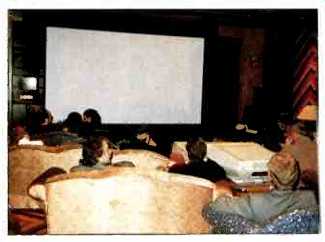DESERT BLOOMS


(top and above)The Fosgate/Barco CES exhibit featured high-definition video
images like the one above. The Winter Consumer Electronics Show was, as
usual, held in Las Vegas in the beginning of January.
Although some exhibits of superb sounding and expensive products are found in the Riviera Hotel, for the most part this is the site for smaller companies looking for a larger share of an already crowded specialty market. From time to time, a company makes it into the "big time" and "graduates" from the Riviera to the East Wing of the main convention center. In recent years, Polk Audio and the Carver Corporation have done just that, joining the ranks of a number of larger, broadly distributed manufacturers. On the convention center's main floor, audio companies are represented but still seem to be pushed aside by video and video accessories. No matter where you roam, however, you can be sure you'll be exposed to the absurd ($4,000 headphones), the visionary (a glimpse of a future car navigational system), and everything in between.
For many reasons, I find the Riviera exhibits more fun to poke around in, and there are old friends at every turn. Not many long-established audio companies bear the name, as well as the continuing presence and philosophical imprint, of their founders. Thus, I was delighted to encounter Richard Shahinian, founder of Shahinian Acoustics. His company manufactures the noted Obelisk loudspeaker, which radiates sound spherically into the listening space.
Dick is an indefatigable music lover who comes to CES with several cases of CDs (and often more than one CD player to boot). Whatever your taste in classical music, he is sure to have superb recorded examples at hand. It was also a pleasure to spend time with Roy Allison of Allison Acoustics.
He still pursues the philosophy which he first espoused many years ago:
Loudspeaker/room boundary conditions can be optimized in the speaker itself, thus providing the user with better speaker interface in the listening room. His new AL series is, however, a standard, free-standing group of speakers. David Hafler is another pioneer, known primarily for electronics. (Who hasn't built a Dynakit?) The Hafler Co. and Acoustat (the well-known brand of electrostatic loudspeakers built in Florida) are now part of Rockford Fosgate in Tempe, Arizona. Finally, I had a good chat with Irving M. Fried. Readers may know of him from his former affiliation with IMF Loudspeakers. His present organization, Fried Products, manufactures quality loudspeakers, some of which use transmission-line loading of the woofers. What distinguishes these "grand old men" is their devotion to music and to honest value for the consumer's dollar. There are doubtless many like them among today's audio entrepreneurs, but that number may not be as large as it once was.
If there was a real show stopper, it was the joint Fosgate/Barco exhibit at the Riviera. Barco is a Belgian manufacturer of video projectors, and Fosgate (in Heber City, Utah) is well known for surround sound decoding of Dolby Stereo soundtracks and other stereo program material. At this impressive exhibit, film clips were shown in normal NTSC color TV with excellent surround sound. Good, but limited by the NTSC 525-line raster.
Then came the piece de resistance.
The large Barco projector had been modified to handle the NHK (Japanese Broadcasting Organization) high-definition television standard (HDTV), and we then saw a program presented on the 1.85-to-1, 7 x 12-foot screen. The image was absolutely gorgeous. There was no sign of video artifacts or misconvergence, and color saturation was excellent. Only the absolute luminance seemed to be a little less than what you would see in a movie theater, but this would likely not be as noticeable on a home screen. The pity is that we cannot get HDTV. It has hurdles to overcome in this country, including an FCC requirement for "backward compatibility," i.e., that the new signal must work, at least in part, on standard NTSC TV sets. Another problem is software. What we saw was reproduced from a 1-inch videotape system operating at about three times the normal video bandwidth. Laser videodiscs are capable of carrying such a signal but with only about 20 minutes of playing time. I understand that future developments, using a shorter laser wavelength for recording and playback of laser videodiscs, could increase playing time proportionally, but this will be far in the future.
It is rare to come across a basic new loudspeaker transducer that is relatively free of problems. Sumo Products of Chatsworth, California presented the Aria, a loudspeaker system designed and built by Highwood Audio of Calgary, Ontario.
Sumo refers to it as a planar loudspeaker; however, that term might be a little misleading, inasmuch as the large diaphragm does not move as a plane. Rather, the highly damped surface is driven at its midpoint by a traditional voice-coil mechanism. Travelling waves are set up in the diaphragm, but they are effectively attenuated by the damping well before they reach the diaphragm boundaries and reflect to cause interference. For high frequencies (short wavelengths), the signal is attenuated early in its path outward; the highs are radiated only from a small portion of the diaphragm, in the vicinity of the voice-coil. For progressively longer wavelengths (lower frequencies), more of the diaphragm is engaged as a radiating surface. In essence, the voice-coil operates virtually as a point source, with all of the advantages in imaging that this implies. Furthermore, since the voice-coil effectively decouples itself from the diaphragm at high frequencies, a single driving mechanism can accommodate the entire frequency band.
At low frequencies, the large expanse of radiating diaphragm does have dipole properties, and, like an electrostatic, it will benefit from a subwoofer (which Sumo offers).
Nominal sensitivity is 86 dB SPL with an input of 2.83 V measured at 1 meter. This is a nominal power input of 2 watts, and with the recommended maximum amplifier rating of 200 watts, levels of 106 dB SPL could be generated at a distance of 1 meter from each loudspeaker. This is not rock-and-roll level, but for most classical and jazz listening in typical living rooms, it will be more than enough-especially with a subwoofer.
Congratulations to all involved.
Pioneer has probably made the most auspicious loudspeaker introduction by a Japanese company since Yamaha introduced the immensely successful NS-1000 some 15 or more years ago. Yamaha was not able to keep the particular "magic" going at a high pitch for more than a few years, but Pioneer seems determined to succeed here.
Although their new Elite series breaks no new ground in transducer design or system configuration, Pioneer's engineers basically optimized each element of the system. (Much of the design was done by the TAD division, their professional loudspeaker products group, whose work is highly regarded by specialists in high-level audio.) They took a no-compromise approach in minimizing enclosure resonances and cone-diaphragm breakup. New materials, such as ceramic graphite and ceramic carbon, were used for optimum stiffness and mass in the mid- and high-frequency transducers. All in all, great care was taken in system configuration and in the design of dividing networks. The high-end models seem capable of superior performance, but these speakers deserve to be presented better than they were at the Show. The demos took place in a small, prefabricated space in a ballroom, with concomitant loss of low-frequency response and interference due to the noisy environment.
In the way of trends in loudspeakers, the three-piece concept is coming on strong. These systems-in powered or passive versions-comprise small satellites (getting even smaller) and a common bass module (also getting smaller).
Obviously, we don't think of such bass units as subwoofers, since they don't really extend the low end much below about 40 Hz. However, they do enable a modest to mid-sized system to fit into almost any space, and they generally offer good performance.
Tower configurations are becoming more prevalent, especially at the high end. This is a trend from Germany and Northern Europe which first surfaced about three years ago.
Broad expanses of oak and walnut finishes with brown grille cloths are on the wane, and in their place we see more glossy piano finishes in a variety of colors. Sounds are getting leaner, with bass more understated than a few years ago.
Each year, the poor acoustic environments prompt several manufacturers to schedule product introductions well away from the din of the main CES centers. Madrigal Audio Laboratories, manufacturers of Mark Levinson electronics products, set up in a quiet hotel meeting room downtown. Here, you could engage engineers in detailed conversation as well as enjoy music under near-ideal conditions. For CD demos, an Accuphase player was teamed with Canadian Mirage loudspeakers, and various Levinson amplifiers were showcased. Gorgeous sound overall.
In a neighboring room, Meridian of England demonstrated a very interesting concept of electronics/ loudspeaker interface which, in effect, makes the loudspeaker the center of a system. Imagine sitting in front of loudspeakers with a remote control in your hands. The control communicates with a unit atop one loudspeaker, and commands are sent back to a CD player or other source.
Volume and equalization settings are made via the remote, so one never needs to leave the listening spot, save to change a disc. The loudspeakers are tri-amplified, and for the sake of simplicity, the entire digital-to-analog conversion (for CD and DAT) is carried out in the receiving unit on top of the loudspeaker. The concept may seem odd at first, but a little thought will convince you that it makes sense.
Excellent sound.
Another off-site demo was held by Nakamichi. The main attraction here was their new Model 1000 DAT recorder. You may recall the original Model 1000, a superlative cassette machine which redefined standards for that product class. It sold, I believe, for around $1,500 and was immensely successful, once professionals and audiophile consumers found out how good it was. Nakamichi is forecasting a similar future for the new Model 1000, and they are probably right! The unit will permit recording at the 44.1-kHz sampling rate, and multiple heads on the helical-scan drum will permit direct read after write, a feature many professional digital recorders do not have. The three piece system (recorder, digital processor, and controller) costs
$10,000 and will accommodate modular sub-sections to upgrade performance from time to time, as the company develops improvements.
The question everyone is asking is how the sale of the 1000 recorder will be viewed by the RIAA, long the holdout against DAT because of its presumed economic consequences on consumer copying of CDs, cassettes, and LPs. Nakamichi is taking a bold step, but someone must do it. I suspect that there will be no problems at all.
While Nakamichi attempts to break the DAT logjam, Wadia is on hand with an external processor which can be used to enhance the performance of any digital source. At the Riviera, the Wisconsin-based manufacturer compared their existing Model 2000 (at $6,500) to their new Model 1000 (at $3,900). For all intents and purposes, there was no substantial difference between the two-and we were listening over a pair of Duntech Marquis loudspeakers driven by Classe Audio amplifiers, easily some of the best sound at the Show. The new unit uses 16-times oversampling, as opposed to 64-times in the Model 2000.
Finally, let us welcome several new organizations to the digital software business. Wilson Audio, long a maker of very high-end loudspeakers and audiophile LPs, introduced its first CDs. Dorian Records debuted some superb organ discs, and Chesky Records, the company which brought us new transfers of 1960s RCA masters long after RCA had given up on them, also introduced Compact Discs.
------- John Eargle
(adapted from Audio magazine, Apr. 1989; by IVAN BERGER)
= = = =